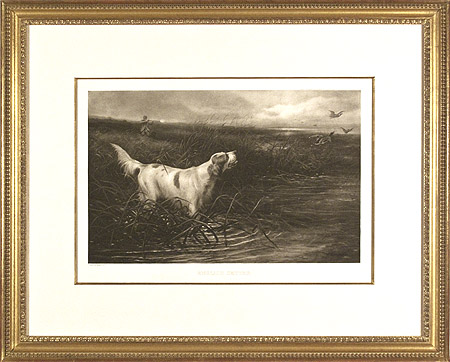
|
|
Of all the late nineteenth century English painters, George Earl is perhaps the most closely associated with the sport of field trials.. He completed two monumental paintings in 1893 entitled "Going North " and "Going South ", both now in the collection of The National Railway Museum in York, England. The first depicts the gathering of sporting dogs with their owners and trainers at the King's Cross Station, ready to embark on their shooting expeditions. "Going South " depicts a similar grouping at the Perth Railway Station, returning from the shooting season in Scotland. One of the most well known of George Earl's sporting paintings, however is "The Field Trial Meet ". It is one of the two known versions by Earl which depicts a field trial meet at Bala in North Wales. The meet did not actually take place, but provided an opportunity for Earl to illustrate many of the important people associated with field trials and the early Kennel Club. The painting is a composition picture of a mystical field trial, portraying over thirty Pointers and Setters and over eighty people: owners, handlers, trainers, dog show judges, breeders and writers about dogs. The site is probably the 64,000 acre estate of Lloyd Prince in Bala, North Wales, for his wife - the only woman in the picture - is shown on a pony in the distance. Bala was the site where The Kennel Club Field Trials of Pointers and Setters took place in 1873. As the late dog historian Gerald Massey has pointed out: "The painting was composite in the sense that some of the portraits were evidently taken from photographs, for it would have been difficult to bring together such a gathering of personalities on amicable terms over a period of fifteen years. It was mythical in that Edward Laverack was dead when Romp's Baby was whelped in 1880, and Mr. J. H. Whitehouse's famous pointer Hamlet would have been in his 19th year. All three, together with Mr. Whitehouse, appear in the engraving for the picture. " Practically every man depicted in George Earl's painting had an active role in developing sporting dogs and the sport of field trials, and at the time it was painted a print was published which provided a schema identifying the principal characters. Little is known about George Earl, other than that he was the patriarch of a family of artists which included his brother, Thomas Earl, his daughter, Maud Earl, and his son from a second marriage, Percy Earl. Thomas is less well known than George, and he seems to have specialized in pet portraits rather than pictures of sporting dogs. Maud Earl, became one of the best known of all dog painters, eventually emigrating to America, as did her stepbrother, Percy Earl. |
Home | About
the WS Gallery | Current
Exhibition | New
Additions | Search Our Inventory
| Commissioning Paintings | 19th
& 20th Century Oils | Contemporary
Artists | Works
on Paper & Collectibles | Books
| Christine Merrill
| Guest book | Email
Us
All images, designs and information on this site
are fully copyrighted © 1999
and may not be reproduced of used in any form or any manner, or displayed in
any way
on any website without the express written consent of The William Secord Gallery,
Inc.
William Secord Gallery, Inc.
29 West 15th Street 4th floor
New York, NY 10011
Between Fifth and Six Avenues
www.dogpainting.com
wsecord@dogpainting.com
Tel. 212-249-0075
212-249-0896
By appointment
